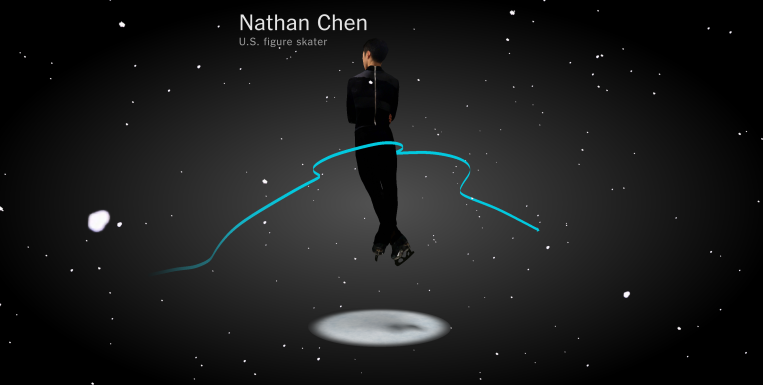Apple’s investment in AR technologies has been ushering in a new wave of apps, from those that let you perform more practical tasks – like visualizing furniture placement in rooms – to those with mass consumer appeal – like AR gaming, including Niantic’s upcoming Harry Potter: Wizards Unite. But AR can also be used to create unique experiences within more traditional apps, too, as The New York Times is showcasing with today’s launch of its first-ever AR experiment for storytelling.
In The NYT’s iOS app for iPhone and iPad, the company is debuting its first AR-enabled article, offering a preview of the Winter Olympics.
The article focuses on top Olympic athletes, including figure skater Nathan Chen, snowboarder Anna Gasser, short track speed skater J.R. Celski, and hockey goalie Alex Rigsby.
In the app, NYT readers can view the athletes appear in the room beside them, zoom in and out, and walk around in 360 degrees to see them from every side.
This lets you get up close and personal with the Olympians, where you’re able to see things like how high Chen’s skates are off the ice when performing a jump, the offset of Celski’s skates, or how far open Alex Rigsby’s glove is when making a save.
iOS users who want to try the AR experience will need to have the latest version of the NYT iOS app, the latest version of iOS, and an iPhone SE, an iPhone 6S or newer, a fifth-generation iPad or an iPad Pro.
To get started, you’ll need to give the app access to your iPhone or iPad’s camera, when requested, then point your phone at some non-reflective surface, like the floor in the room, for example. When you see the image, you can tap to place it into position, then walk up to it and around it. You can even bend down and look up at the image, too.
The overall experience is sponsored by Olympic Official Outfitter Ralph Lauren, and it also includes a Ralph Lauren AR advertisement.
The ad gets you up close with the athletes, as well, but instead of showcasing their abilities, it focuses on their clothing. In it, ice dancers Maia and Alex Shibutani appear in AR, modeling the official Ralph Lauren Team USA Opening Ceremony Parade uniforms.
T Brand Studio worked with Ralph Lauren on the ad’s creative design and concept, and the ad itself was then produced by NYT experiential design agency Fake Love. The ad appears further down in the AR-enhanced article, but is also available in The Times news feed.
This is the first time an advertiser has offered an AR ad experience in The NYT app for iOS, the company says.
Editorial production for the AR piece as a whole was done in-house, including the platform side development. The team is currently using Apple’s ARKit, but says that it’s working to develop similar AR experiences for Android users.
Google’s ARCore technology is still in developer preview, but The NYT expects to offer AR in its Android Newsreader app shortly after ARCore publicly launches.
The NYT regularly tests out new technologies for use in storytelling, including things like VR and 360-degree video; it was only a matter of time until it added AR to that lineup, too.
“The Times has been among the most innovative digital storytellers for many years. On desktop, mobile, in our exploration of data visualization and other forms of visual journalism, including virtual reality, we’ve been committed to creating the most compelling and vibrant report possible, and this experiment in AR is a part of that,” said Steve Duenes, NYT’s assistant masthead editor, in a statement.
“The Times covers today’s most compelling news events from around the world. And now, our readers can get closer to these stories and subjects, from a possible border wall to a figure skater’s quadruple jump. They can take in the size, shape and details of the objects at the center of our coverage,” he added.
The NYT told us the reference to a “possible border wall” is meant to offer an example of where AR could enhance a reader’s understanding of the story, by displaying an object in three-dimensions, where scale matters, and were human interaction – like walking up to the wall – could give you a better idea of what it’s really like.
However, the company hasn’t yet committed to building out an AR “border wall” as of yet. It says it’s still planning out its editorial calendar for AR for now.
